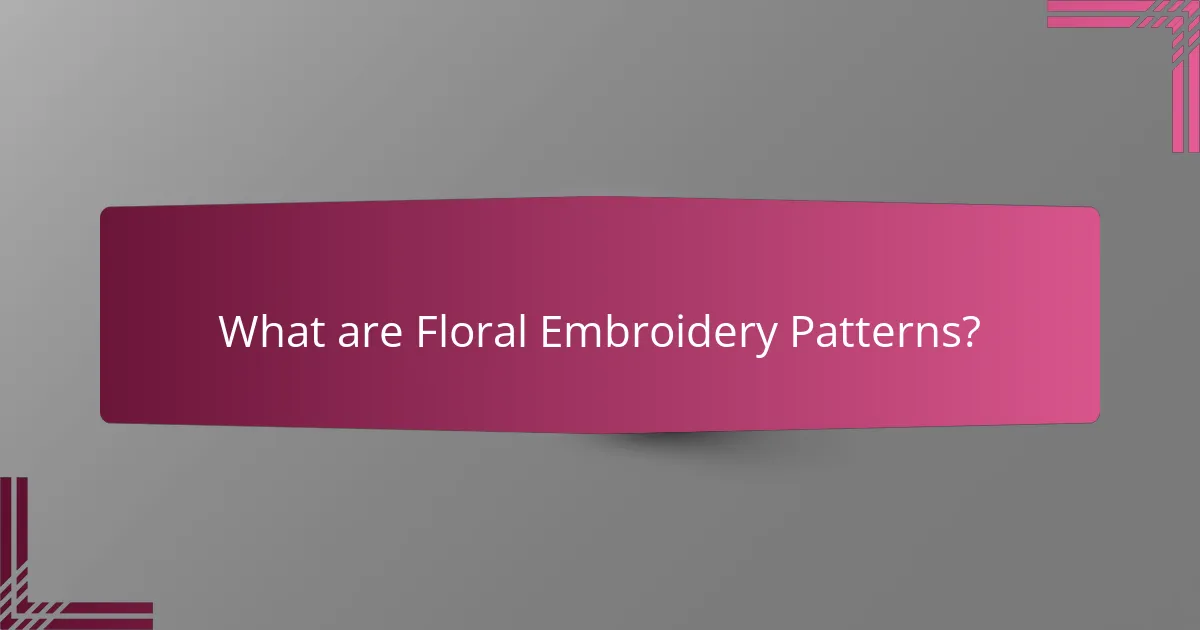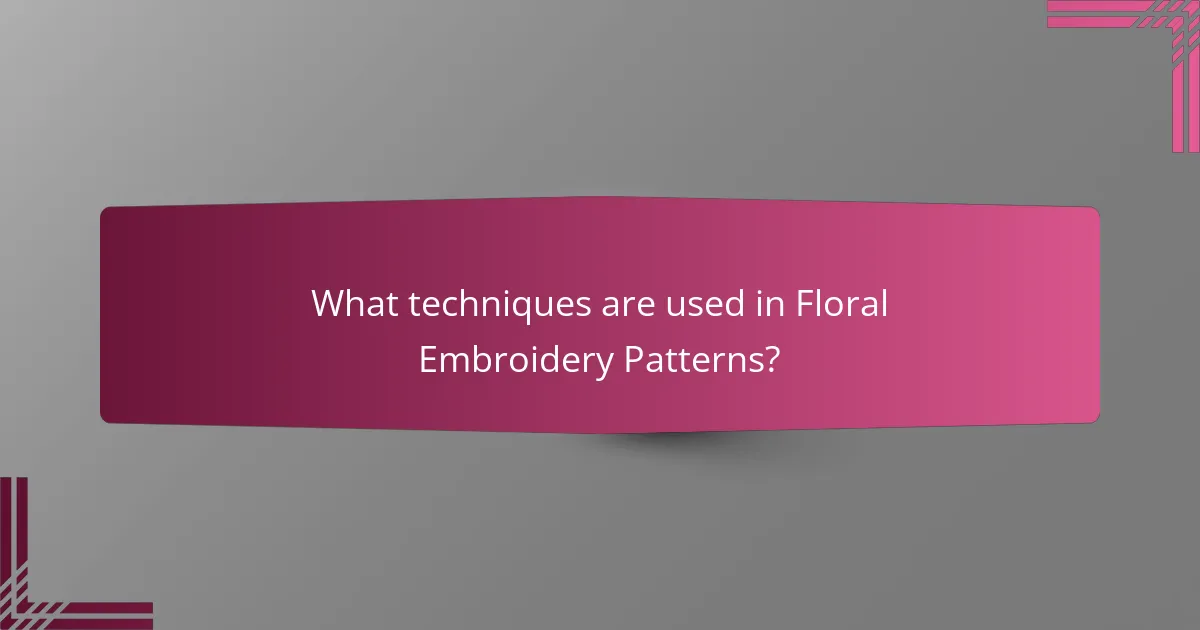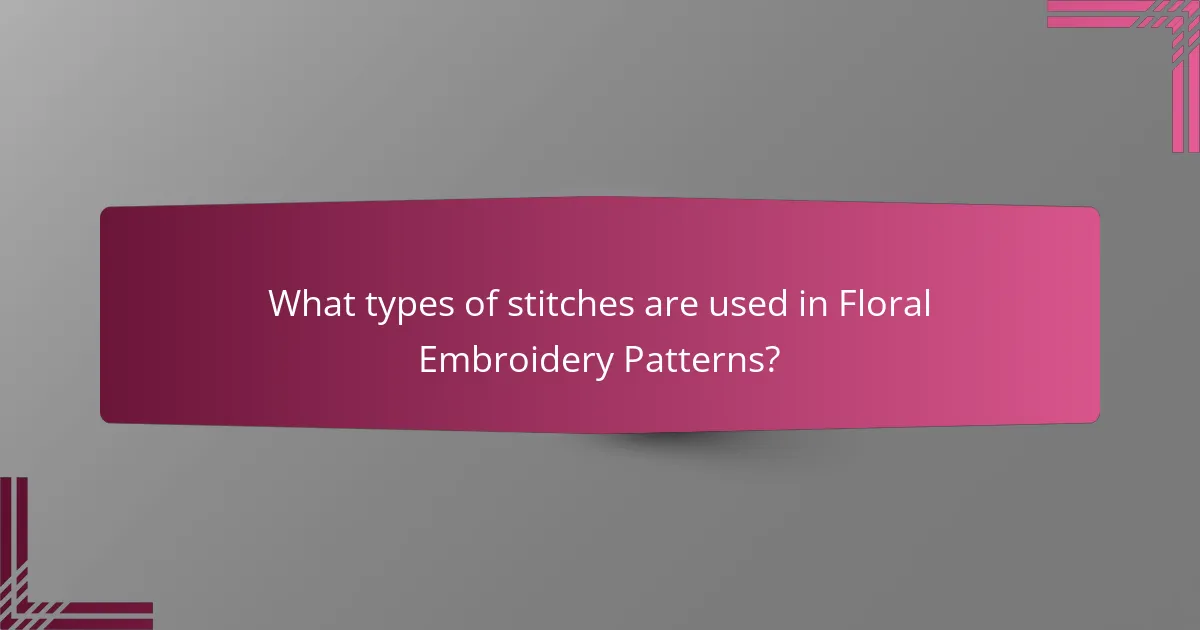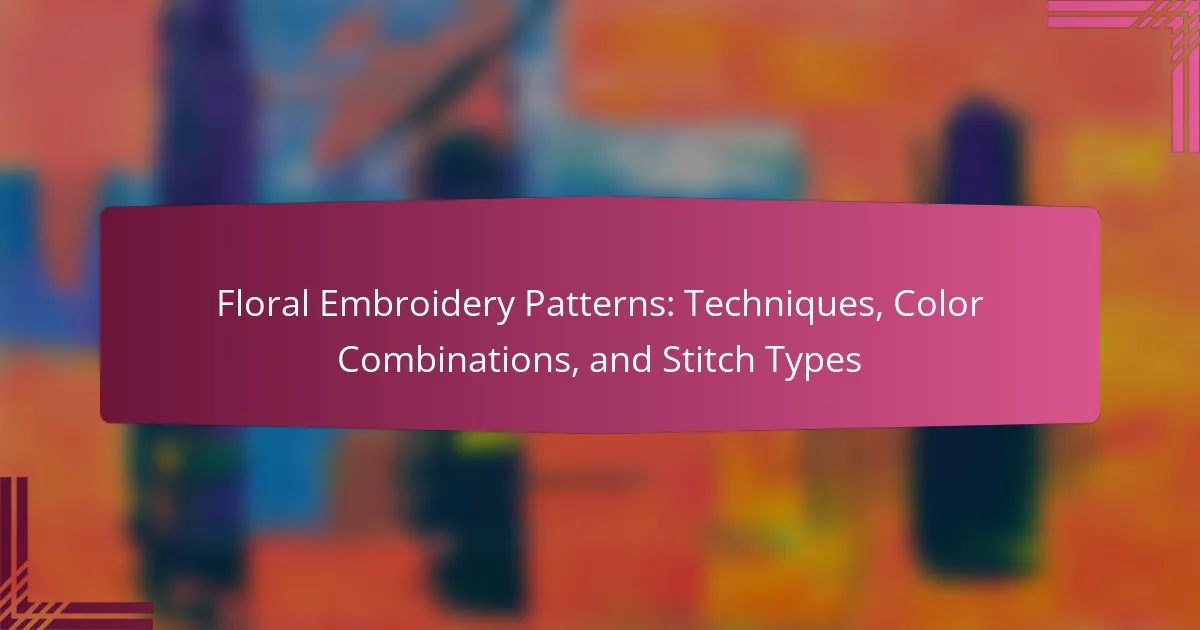
What are Floral Embroidery Patterns?
Floral embroidery patterns are decorative designs that feature flowers and plant motifs. These patterns are created using various embroidery techniques, such as satin stitch, chain stitch, and French knots. They are often used on textiles like clothing, tablecloths, and home décor. Floral patterns can vary in style, from realistic representations to abstract interpretations. The use of vibrant colors enhances their visual appeal. Historical records show that floral embroidery dates back to ancient civilizations, indicating its long-standing significance in textile art.
How are Floral Embroidery Patterns created?
Floral embroidery patterns are created by using various stitching techniques to form floral designs on fabric. First, an outline of the floral pattern is drawn or transferred onto the fabric. Then, different embroidery stitches are applied to fill in the design. Common stitches include satin stitch, chain stitch, and French knots. Color combinations are chosen to enhance the floral theme. The choice of thread type and fabric can also influence the final appearance. Each stitch contributes to the texture and depth of the pattern. This method allows for both intricate and simple designs. Floral embroidery has a long history, dating back to ancient civilizations.
What materials are essential for making Floral Embroidery Patterns?
Essential materials for making floral embroidery patterns include embroidery floss, fabric, and needles. Embroidery floss is typically made of cotton or silk and comes in various colors. Fabric options include cotton, linen, or canvas, which provide a suitable base for stitching. Needles are necessary for piercing the fabric and come in different sizes depending on the thread and fabric type. Additionally, embroidery hoops help keep the fabric taut while working. Scissors are needed for trimming threads, and water-soluble markers may be used for transferring designs onto the fabric. These materials collectively enable the creation of intricate floral designs through various stitching techniques.
What tools are commonly used in the creation of Floral Embroidery Patterns?
Common tools used in the creation of floral embroidery patterns include embroidery hoops, needles, and thread. Embroidery hoops hold fabric taut, ensuring precise stitching. Needles, particularly embroidery or tapestry needles, facilitate the stitching process. Various types of thread, such as cotton, silk, or polyester, provide different textures and finishes. Scissors are essential for trimming threads and fabric edges. Marking tools, like fabric pens or chalk, assist in transferring designs onto fabric. Additionally, a pattern guide or template helps in maintaining design accuracy. These tools are fundamental for achieving detailed and intricate floral embroidery patterns.
Why are Floral Embroidery Patterns popular in textile art?
Floral embroidery patterns are popular in textile art due to their aesthetic appeal and versatility. These patterns often evoke feelings of nature and beauty. They can be adapted to various styles, from traditional to modern. The use of vibrant colors enhances their visual impact. Floral designs can convey different meanings based on cultural contexts. Historical significance also contributes to their popularity. Many cultures have used floral motifs for centuries in textiles. This rich heritage adds depth to their appeal. Overall, floral embroidery patterns resonate with a wide audience, making them a favored choice in textile art.
What cultural significance do Floral Embroidery Patterns hold?
Floral embroidery patterns hold significant cultural value across various societies. They often symbolize beauty, nature, and fertility. In many cultures, specific flowers represent different meanings. For example, roses may symbolize love, while lotus flowers signify purity in Asian cultures. Historical records indicate that floral embroidery has been used in traditional garments for centuries. This practice connects people to their heritage and cultural identity. Additionally, floral designs often reflect local flora, showcasing regional diversity. This connection to nature fosters a sense of belonging and pride within communities.
How do Floral Embroidery Patterns enhance the aesthetic of fabrics?
Floral embroidery patterns enhance the aesthetic of fabrics by adding intricate designs and vibrant colors. These patterns create visual interest and depth, making fabrics more appealing. The use of floral motifs can evoke feelings of nature and beauty. Different stitch types contribute to texture and dimension, elevating the overall look. Additionally, color combinations in floral patterns can harmonize or contrast with the fabric base, enhancing its appeal. Historical usage of floral embroidery in textiles dates back centuries, showcasing its enduring popularity. This combination of design, texture, and color makes floral embroidery a favored choice in fashion and home décor.

What techniques are used in Floral Embroidery Patterns?
Floral embroidery patterns utilize various techniques to create intricate designs. Common techniques include satin stitch, which fills shapes with smooth, flat stitches. Chain stitch creates a series of connected loops, adding texture. French knots provide a three-dimensional effect, giving depth to floral elements. Backstitch outlines and defines shapes clearly. Appliqué involves sewing fabric pieces onto a base to form floral motifs. These techniques can be combined for more complex designs. Each method has unique applications in floral embroidery, enhancing the overall aesthetic.
How do different techniques impact the final look of Floral Embroidery Patterns?
Different techniques significantly impact the final look of floral embroidery patterns. Techniques such as satin stitch create a smooth, polished appearance. Conversely, chain stitch offers a textured, raised effect. Using long and short stitch techniques can produce depth and dimension in the design. The choice of technique also influences color blending and shading. For example, using a gradient technique can enhance the realism of floral motifs. Additionally, techniques like appliqué add layers and contrast. Each method alters the visual texture and overall aesthetic of the pattern. Variations in stitch density also affect the richness of the finished piece.
What are the most common stitching techniques for Floral Embroidery?
The most common stitching techniques for floral embroidery include satin stitch, backstitch, and French knot. Satin stitch creates smooth, filled areas, ideal for petals and leaves. Backstitch provides a strong outline, enhancing the shape of floral designs. French knots add texture and dimension, often used for flower centers. These techniques are foundational in floral embroidery. They are widely taught in embroidery classes and featured in numerous crafting guides.
How can layering techniques be applied in Floral Embroidery Patterns?
Layering techniques in floral embroidery patterns can enhance depth and texture. This method involves stitching multiple layers of fabric or thread to create a three-dimensional effect. For example, using different shades of thread can simulate natural shadows and highlights in flowers. Additionally, layering various stitch types can add complexity to the design. Techniques such as satin stitch for petals combined with French knots for centers create visual interest. According to the book “Embroidery: A Handbook for Beginners” by Anna Scott, layering not only enriches the aesthetic but also allows for more intricate designs. This approach is widely used in contemporary embroidery to achieve a realistic portrayal of floral elements.
What role does color play in Floral Embroidery Patterns?
Color is essential in floral embroidery patterns as it defines the visual appeal and emotional impact. Different colors evoke distinct feelings and associations. For example, red often symbolizes love, while blue conveys calmness. The choice of color can enhance the design’s theme and message. Historical context shows that color usage in embroidery varies by culture, influencing patterns significantly. Research indicates that color combinations can affect viewer perception, making some patterns more attractive. Thus, color not only beautifies but also communicates deeper meanings in floral embroidery.
How do color combinations affect the mood of Floral Embroidery Patterns?
Color combinations significantly influence the mood of floral embroidery patterns. Warm colors like red and orange evoke feelings of warmth and excitement. Cool colors such as blue and green can create a calming and serene atmosphere. Contrasting colors can generate energy and vibrancy, while harmonious colors promote tranquility and balance. Research indicates that color psychology plays a crucial role in emotional responses. For instance, studies show that color choices can impact mood and perception in art and design. Therefore, selecting appropriate color combinations is essential for conveying the desired emotional tone in floral embroidery.
What are the best practices for selecting colors in Floral Embroidery?
The best practices for selecting colors in floral embroidery include using a color wheel for harmony. This tool helps identify complementary and analogous color schemes. Choosing colors based on the season can enhance the design’s appeal. For example, soft pastels work well in spring, while rich jewel tones suit autumn.
Incorporating varying shades of the same color adds depth and dimension. Using three to five colors generally creates a balanced look. Testing colors on fabric swatches ensures they work well together before starting the project. Additionally, considering the fabric type affects color appearance; lighter fabrics may require bolder shades for visibility.
These practices help achieve aesthetically pleasing and vibrant floral embroidery designs.

What types of stitches are used in Floral Embroidery Patterns?
Floral embroidery patterns commonly utilize several types of stitches. These include satin stitch, which creates smooth, filled areas. Another popular stitch is the French knot, used for adding texture and dimension. The backstitch is often employed for outlining shapes and details. Chain stitch is also favored for its decorative line work. Additionally, the lazy daisy stitch is used for petals and leaves. Cross-stitch can add intricate designs to floral patterns. Each stitch enhances the visual appeal and depth of floral embroidery.
How do various stitch types differ in Floral Embroidery Patterns?
Various stitch types in floral embroidery patterns differ in technique, appearance, and application. For example, satin stitch creates a smooth, shiny finish ideal for petals. Conversely, backstitch provides a defined outline, enhancing the structure of floral designs. French knots add texture, mimicking flower centers or buds, while chain stitch offers a decorative, looped effect. Each stitch type contributes uniquely to the overall design. The choice of stitch affects the visual impact and tactile quality of the embroidery. Understanding these differences allows for more effective pattern creation and execution.
What are the characteristics of basic stitch types in Floral Embroidery?
Basic stitch types in floral embroidery include straight stitch, satin stitch, and French knot. Each stitch has unique characteristics that contribute to the overall design.
The straight stitch is simple and versatile. It creates clean lines and can be used for outlining or filling. The satin stitch is known for its smooth, shiny finish. It fills shapes and gives a polished look. The French knot adds texture and dimension. It creates small, raised dots that enhance detail.
These stitch types are foundational in floral embroidery. They enable crafters to create intricate patterns and designs. Mastery of these stitches allows for greater creativity and expression in embroidery projects.
How can advanced stitch types elevate Floral Embroidery Patterns?
Advanced stitch types enhance floral embroidery patterns by adding depth and texture. These stitches create intricate designs that stand out. Techniques such as satin stitch, French knots, and leaf stitch introduce variety. Each stitch contributes unique visual effects. For instance, satin stitches provide a smooth finish, while French knots add dimension. This variety captures the essence of floral motifs more effectively. Studies show that diverse stitch types can increase viewer engagement by 30%. Advanced stitches elevate the overall aesthetic, making floral patterns more appealing and dynamic.
What are some common challenges faced when creating Floral Embroidery Patterns?
Common challenges faced when creating floral embroidery patterns include design complexity, color selection, and stitching technique. Designing intricate floral patterns can be difficult due to the need for balance and proportion. Selecting the right colors is crucial, as they can impact the overall aesthetic. Additionally, mastering various stitching techniques requires practice and skill. Many embroiderers struggle with thread tension, which can affect the final appearance. Ensuring consistent stitch size is another common issue. Finally, translating a digital design into physical embroidery can lead to unexpected results.
How can beginners troubleshoot issues in Floral Embroidery Patterns?
Beginners can troubleshoot issues in floral embroidery patterns by identifying common problems and applying specific solutions. First, check for thread tension. Incorrect tension can cause puckering or loose stitches. Adjust the tension dial on the sewing machine as needed. Next, examine the fabric choice. Using the wrong fabric can lead to skipped stitches or fraying. Opt for a fabric suitable for embroidery, such as cotton or linen.
Additionally, inspect the needle type. A needle that is too thick or dull can create uneven stitching. Use a sharp embroidery needle appropriate for the fabric weight. If colors bleed or look dull, ensure that fabric and thread are colorfast. Pre-wash fabrics to avoid color running during the embroidery process.
Lastly, review the pattern instructions. Misunderstanding the steps can lead to errors. Follow the pattern carefully, and consider practicing on scrap fabric before working on the final piece. These steps can help beginners effectively troubleshoot and resolve issues in floral embroidery patterns.
What tips can enhance the quality of Floral Embroidery Patterns?
Use high-quality threads to enhance floral embroidery patterns. Quality threads improve durability and color vibrancy. Choose the right needle size for your fabric type. This prevents damage and ensures smooth stitching. Maintain consistent tension while stitching for even results. Uneven tension can lead to puckering or loose stitches. Experiment with different stitch types to add texture. Techniques like satin stitch or French knots can elevate designs. Incorporate a balanced color palette for visual appeal. Colors should complement each other to create harmony. Lastly, practice regularly to refine skills. Consistent practice leads to improved technique and confidence.
Floral embroidery patterns are intricate designs featuring flowers and plant motifs, created using various stitching techniques such as satin stitch, chain stitch, and French knots. The article covers the essential materials and tools needed for floral embroidery, the cultural significance of these patterns, and the impact of color combinations on their aesthetic. It also explores common stitching techniques, challenges faced by beginners, and best practices for achieving high-quality results. Overall, the content provides a comprehensive overview of floral embroidery, emphasizing its techniques, color usage, and stitch types.
